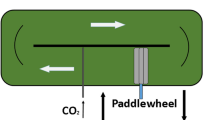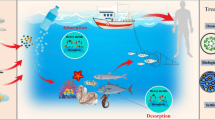Abstract
A microporous material denoted ETS-4 was used as the decontaminant agent to treat water with a low level of Hg contamination. The effectiveness of the treatment was evaluated by assessment of the efficiency of Hg removal and ecotoxicological responses. The results showed that under highly competitive conditions the removal of Hg ranged between 58 % and 73 % depending upon the initial Hg concentration, and that Hg removal was reflected in decreased toxicity to some organisms. The ecotoxicological data indicated that the bacterium Vibrio fischeri was the least sensitive organism tested, as no toxicity was observed in either pre- or post-treatment waters. Daphnia magna was highly sensitive to Hg. Mercury removal by ETS-4 was not sufficient to completely remove the toxicity of Hg to D. magna. However, it was effective in the complete reduction of toxicity for the green alga, Pseudokirchneriella subcapitata.

Similar content being viewed by others
References
ASTM (1992) Standard guide for conducting renewal life-cycle toxicity tests with Daphnia magna. In: Annual book of ASTM standards, vol 11.04. vol E 1193-87. Philadelphia, pp 812–828
AZUR (1998) Microtox® Omni manual. Microbics Corporation, Carlsbad, CA
Coelho JP, Nunes M, Dolbeth M, Pereira ME, Duarte AC, Pardal MA (2008) The role of two sediment-dwelling invertebrates on the mercury transfer from sediments to the estuarine trophic web. Estuar Coast Shelf Sci 78(3):505–512. doi:10.1016/j.ecss.2008.01.017
EC (1992) Biological test method: growth inhibition test using the freshwater alga Selenastrum capricornutum. Report EPS 1/RM/25, Environment Canada, Ottawa, ON, Canada
Figueira P, Lopes CB, Daniel-da-Silva AL, Pereira E, Duarte AC, Trindade T (2011) Removal of mercury (II) by dithiocarbamate surface functionalized magnetite particles: application to synthetic and natural spiked waters. Water Res 45(17):5773–5784. doi:10.1016/j.watres.2011.08.057
Finney D (2009) Probit analysis. Cambridge University Press, London
Ghasemi Z, Seif A, Ahmadi TS, Zargar B, Rashidi F, Rouzbahani GM (2012) Thermodynamic and kinetic studies for the adsorption of Hg(II) by nano-TiO2 from aqueous solution. Adv Powder Technol 23(2):148–156. doi:10.1016/j.apt.2011.01.004
Imani S, Rezaei-Zarchi S, Hashemi M, Borna H, Javid A, Zand AM, Abarghouei HB (2011) Hg, Cd and Pb heavy metal bioremediation by Dunaliella alga. J Med Plants Res 5(13):2775–2780
Lo SI, Chen PC, Huang CC, Chang HT (2012) Gold nanoparticle–aluminum oxide adsorbent for efficient removal of mercury species from natural waters. Environ Sci Technol 46(5):2724–2730. doi:10.1021/es203678v
Lopes CB, Otero M, Lin Z, Silva CM, Rocha J, Pereira E, Duarte AC (2009) Removal of Hg2+ ions from aqueous solution by ETS-4 microporous titanosilicate—kinetic and equilibrium studies. Chem Eng J 151(1–3):247–254. doi:10.1016/j.cej.2009.02.035
Lopes CB, Otero M, Lin Z, Silva CM, Pereira E, Rocha J, Duarte AC (2010) Effect of pH and temperature on Hg(2+) water decontamination using ETS-4 titanosilicate. J Hazard Mater 175(1–3):439–444. doi:10.1016/j.jhazmat.2009.10.025
Lopes CB, Pereira E, Lin Z, Pato P, Otero M, Silva CM, Rocha J, Duarte AC (2011) Fixed-bed removal of Hg(2+) from contaminated water by microporous titanosilicate ETS-4: experimental and theoretical breakthrough curves. Microporous Mesoporous Mater 145(1–3):32–40. doi:10.1016/j.micromeso.2011.04.019
Lopes CB, Oliveira J, Rocha L, Tavares D, Silva C, Silva S, Hartog N, Duarte A, Pereira E (2013) Cork stoppers as an effective sorbent for water treatment: the removal of mercury at environmentally relevant concentrations and conditions. Environ Sci Pollut Res 1–14. doi:10.1007/s11356-013-2104-0
Lv JT, Luo L, Zhang J, Christie P, Zhang SZ (2012) Adsorption of mercury on lignin: combined surface complexation modeling and X-ray absorption spectroscopy studies. Environ Pollut 162:255–261. doi:10.1016/j.envpol.2011.11.012
Mishra A, Tripathi BD (2008) Utilization of fly ash in adsorption of heavy metals from wastewater. Toxicol Environ Chem 90(6):1091–1097. doi:10.1080/02772240801936786
OECD (2004) Daphnia sp. acute immobilisation test. Guideline for testing of chemicals, No. 202. Paris, France
OECD (2006) Freshwater alga and cyanobacteria growth inhibition test. Guideline for testing of chemicals 201. Paris, France
Otero M, Lopes CB, Coimbra J, Ferreira TR, Silva CM, Lin Z, Rocha J, Pereira E, Duarte AC (2009) Priority pollutants (Hg(2+) and Cd(2+)) removal from water by ETS-4 titanosilicate. Desalination 249(2):742–747. doi:10.1016/j.desal.2009.04.008
Popa K, Pavel CC (2012) Radioactive wastewaters purification using titanosilicates materials: state of the art and perspectives. Desalination 293:78–86. doi:10.1016/j.desal.2012.02.027
Popa K, Pavel CC, Bilba N, Cecal A (2006) Purification of waste waters containing 60Co2+, 115mCd2+ and 203Hg2+ radioactive ions by ETS-4 titanosilicate. J Radioanal Nucl Chem 269(1):155–160. doi:10.1007/s10967-006-0245-z
Rocha L, Lopes CB, Borges JA, Duarte AC, Pereira E (2013) Valuation of unmodified rice husk waste as an eco-friendly sorbent to remove mercury: a study using environmental realistic concentrations. Water Air Soil Pollut 224(7):1–18. doi:10.1007/s11270-013-1599-9
Stein J (1973) Handbook of phycological methods—culture methods and growth measurements Cambridge. University Press, London
Tavares DS, Daniel-da-Silva AL, Lopes CB, Silva NJO, Amaral VS, Rocha J, Pereira E, Trindade T (2013) Efficient sorbents based on magnetite coated with siliceous hybrid shells for removal of mercury ions. J Mater Chem A 1(28):8134–8143. doi:10.1039/c3ta10914c
USEPA (1994) Short-term methods for estimating the chronic toxicity of effluents and receiving waters to freshwater organisms. USEPA, Washington, DC
Acknowledgments
The authors thank Fundação para a Ciência e a Tecnologia (FCT) (PEst-C/MAR/LA0017/2013; PEst-C/CTM/LA0011/2013), FSE and POPH for funding. C. B. Lopes and L. S. Rocha are grateful for their post-doctoral Grants (SFRH/BD/45156/2008; SFRH/BD/47166/2008).
Author information
Authors and Affiliations
Corresponding author
Rights and permissions
About this article
Cite this article
Lopes, C.B., Lopes, I., Rocha, L.S. et al. A Multidisciplinary Approach to Evaluate the Efficiency of a Clean-Up Technology to Remove Mercury from Water. Bull Environ Contam Toxicol 93, 138–143 (2014). https://doi.org/10.1007/s00128-014-1272-z
Received:
Accepted:
Published:
Issue Date:
DOI: https://doi.org/10.1007/s00128-014-1272-z




